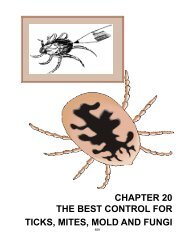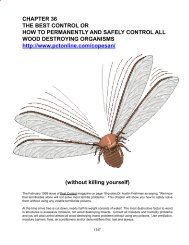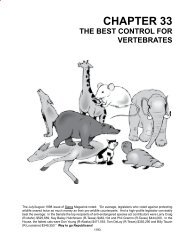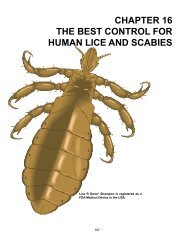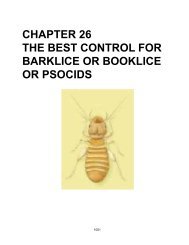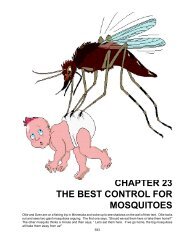like colds, and headaches and spend a total of $14 billion a year on these products - hopefully the public willnow begin to try some of these “non-traditional” pest control methods or Pestisafes ® . <strong>The</strong> Author’s books,articles, letters and research on Integrated (the Author prefers Intelligent) Pest Management ® list thousands ofadditional techniques, companies, products, controls, inspections, and/or other alternatives to toxic, volatile,synthetic pesticide poisons. <strong>The</strong> one thing that continues to amaze the Author most is that in a world dying frompollution - filled with resistant pests - the Author’s constantly asked to prove “his Pestisafes ® or controls” arecompletely safe, legal and/or totally and instantly effective! Obviously “the Author’s controls” or Pestisafes ® workbetter than and are much safer than most poisons - poisons are poisons - most of “my controls” use materialscreated to be eaten or to be used on or near people and pets - volatile, registered pesticide poisons were madeto kill! Even though some of his research shows natural products can kill too, usually they are toxic only ifingested and are not volatile. On May 6, 1996 approximately 200 least-toxic pesticide active ingredientswere exempted from registration with the EPA. (See 40 CFR Part 152 and the Federal Register March 6,1996 P.8870.) By initiating this action, the EPA wanted to encourage the sale and distribution of least-toxic (andobviously non-toxic) pesticides. Among the newly exempted pesticides are castor oil, geranium oil, mint and mintoil, potassium sorbate, sesame, sodium chloride (common salt), garlic, rosemary, citronella, clove, cinnamon,lemongrass, peppermint, thyme, dolomite, eggs, glue, medicated feed, vermiculite, soybean, wintergreen andcorn oils. Producers and/or formulators are now free to sell these materials as pesticides without prior approvalor registration with the EPA. Tree Oils Comment: Hexa-hydroxyl is contained in many tree oils to protect treesfrom insect attack and is approved for use in food and beverages by the FDA, yet it quickly kills or repels insectsfor up to 2 days - encapsule it in sodium borate and you have a long-term residual Pestisafe ® . Hexa-hydroxylblocks octopamine, an essential neurotransmitter only present in insects (its like giving them LSD). EcoSmartTechnologies has registered this safe material as a biological pesticide. Remember, a registered pesticide mustbe used in direct accordance with its ever-changing label and labeling - most of the Author’s favorite things/controls/Pestisafes ® are not (registered) pesticide poisons and have no labels, so common sense must be used.Always try to use the safest poison alternatives possible so you can do the most good and the least harm. Whenall else fails, or if none of <strong>The</strong> Basic <strong>Control</strong>s or other methods of treatment are not fast enough, safe enoughor appropriate enough, the hand removal of weeds, insects or pests may be necessary or simply step on them. . . simply kick them in their posterior sternal integumental plates!“True IPM or Intelligent Pest Management ® is an ever-changing process or learning experience in the selection,integration and implementation of all the currently available pest control strategies based on predicted economic,ecological, and societal consequences and/or it can be defined as an ever-changing process of determining if anycontrol is even needed; how, when, and where control efforts should be used, and what Pestisafes ® , pesticides(non-volatile) products, techniques, biological controls and/or tactics should be employed.” Always choose thesafest alternative possible. — S.L.T.Garlic Cautions - When it is crushed /squeezed or otherwise rendered the amino acid allin is enzymaticallynaturally converted to allicin, its primary pesticidal substance; the smellier the garlic the more toxic it is as apesticide. Allicin is a cholinesterase inhibitor and can be lethal to plants. Garlic inhibits or repels plant pathogens,e.g., fungus, mildew, scab, bacterial, nematodes, insects, aquatic snails, ticks, wasps, houseflies and viral disease.Homogenize 2 bulbs of garlic (basically 1/4 lb.) in a blender with a quart of water and a few drops of liquid soapand then strain through cheese cloth to obtain a liquid pesticidal solution.Chemical Caution - In the night of 8/7/44 about 1200 sheep where killed by the fumes of a poison spraydrifting from an olive grove in the Saucelito district of California. What did we learn from all of this unnecessarydeath? According to recent surveys and reports, 5 - 10 million household poisonings occur each year due totoxic chemical (poison) exposure. Many are fatal and most of the victims are children. 150 of the chemicalscommonly found in homes have been linked to allergies, birth defects, cancer and psychological abnormalities.Side effects from chemical use include respiratory problems, stuffy noses, itchy eyes and throats, ear infections,asthma, bronchitis, fatigue, headaches, seizures and death.Enzyme Cleaner Cautions - Be sure you use Safe Solutions Tweetmint Enzyme Cleaner with or withoutPeppermint, Lice R Gone ® or Pet Wash ® products or soaps. Remember if you fertilize and use any of theseenzymes 2 weeks before or after your fertilizer application - you may kill or severely damage your plants.Enzyme cleaners cause plants to grow longer roots and to become more efficient in assimilating nutrients, e.g.,fertilizers. Some people are concerned that protease enzymes may cause a severe allergic reaction. Alwaystest a small area of your skin before you apply enzymes or another product. Remember, protease enzymes478
should never be more than 1% of the product; some enzyme cleaners can cause occupational asthma problemsand anaphylactic shock. Safe Solutions, Inc. has the only licensed use to a USA and Australian patent onthe use of enzymes and surfactant blends to control pests. Try their Not Nice to Bugs ® .Plant Spray Cautions - Always test a spray on a small area of foliage before spraying Pestisafes ® or pesticides orfertilizers on the entire plant. Even if no contraindications are seen initially, if the foliage shows any subsequentsign of withering, discoloration, burning, etc., discontinue further treatment or at least dilute your spray until nofurther damage occurs to the foliage/plant.Pesticidal Claims - Only if a complaint is filed does EPA check into an “unregistered” pesticide. You can notput anything but 100% of the specific items from the exempted active and inert ingredient lists into an exemptedpesticide product, or you will have to register your entire product as a pesticide. In the September 1988 issueof Pest <strong>Control</strong> Technology, (page 18) Stoy A. Hedges, B.C.E., R.S. from Terminex International noted in part:“Although not registered with EPA as a disinfectant, household bleach, such as Dow’s Clorox ® , does in fact state‘disinfectant’ on the label, although specific directions for such use are obviously not provided on the productlabel. It is common knowledge that hospitals, clinical laboratories and others use household bleach as a disinfectantfor blood-borne pathogens.” Mr. Hedges notes the Centers for Disease <strong>Control</strong> have several bulletinsthat make such recommendations.Safety - <strong>The</strong> bottom line on personal safety is you. <strong>The</strong>re simply is no substance that is totally safe foreveryone or every plant. A major step toward your own safety is taken when you realize that your safety and thatof your family and pets is truly your own responsibility. It is easy to blame others, e.g., the poison “industry” forharming you or yours - but that will not save them or you. Remember, virtually any spray may burn plantsor irritate someone - so test your “mix” on a few leaves or a small area of the skin first.How to make colloidal solutions - Pass a small electrical current through both wires/rods in a solution, e.g.,use a copper wire/rod and a galvanized iron wire/rod in an ammonia nitrate solution to produce colloidal coppernitrate which is great for lawns. Use 2 silver wires/rods in a saline solution to produce colloidal silver. Use 2 ironwires/rods in a saline solution to produce colloidal iron. Use 2 gold wires/rods in a nitrate solution to producecolloidal gold.Another alternative insect control - Pulverize in a blender a couple of whole cayenne peppers, a large onionand a whole garlic bulb with a little water. When done, mix in a gallon of water, let stand 24 hours and thenstrain. Spray mix as needed to control insects.Still another alternative insect control spray is to blend grated Ivory or olive oil bar soap with either of thefollowing: citrus, garlic, mint, rhubarb leaves, pepper, vinegar or vegetable oil in a water-based spray. Alwaysremember that water-based sprays can burn plants on hot, sunny days!All Purpose Weed Killers - Boil 1 qt. water; add 2 T. salt and 5 T. vinegar. Pour directly on weeds in cracks,etc. while the mix is still hot. Second mix: Mix 2 - 4 T. powdered citric acid and 1 T. dish soap in 1 qt. vinegarand thoroughly spray. Third mix: 1 gal. red or white vinegar, 2 c. table salt, 5 T. dishwashing liquid; mix andsoak plants. Fourth mix: 1/2 c. borax per gallon water. You can add a “kicker by adding 2 c. rubbing alcohol;if you do, be careful not to get in your eyes. All of these mixes work better on hot, sunny days.Aphid and mite repellent - Chop/mash 1 c. of hot red pepper, 2 cloves garlic and soak in 1 c. water, covered,for 24 hours. (You might want to wear disposable gloves and refrain from touching your eyes.) Strain and mistyour plants with this mixture as needed.Surfactant Note - Unregistererd surfactants have been used with pesticides for years to improve the poison’sperformance. <strong>The</strong>y are not required to be registered even though they, obviously, help control pest problems.I firmly believe (and have also proven) that using just the unregistered surfactants and not including any of thepesticides will provide basically the same degree of pest control, but that is “illegal” to many “regulators”.What is the world population of insects and how much do they weigh? Brian Hocking, a Canadianentomologist, estimated there were about 1 quintillion individuals at any given time - that is a one with 18 zerosafter it. Based on this figure, he calculated their combined weight at 27 billion tons or 12 times the weight of the479
- Page 1:
CHAPTER 11SAFE AND FAR MOREEFFECTIV
- Page 4 and 5:
pesticide poisons do - to them the
- Page 6 and 7:
American Beautyberry (Callicarpa am
- Page 8 and 9:
packets in 4 days or less. Aspartam
- Page 10 and 11:
Baking Soda - Baking soda or sodium
- Page 13 and 14:
Bioderivatives - are substances whi
- Page 15 and 16:
Bird feeders - will attract more th
- Page 17 and 18:
an abrasive action on the insect wh
- Page 19 and 20:
pathogens - volatiles produced duri
- Page 21 and 22:
ground, grain and stored product ap
- Page 23 and 24:
epels many insects, including flies
- Page 25 and 26:
een used medically since at least t
- Page 27 and 28:
Collateral Damage - When you spray
- Page 29 and 30:
Cottonseed Meal - is a source of ni
- Page 31 and 32:
Desiccants - Hot air, dehumidifiers
- Page 33 and 34:
Dogs - have been trained to sniff o
- Page 35 and 36:
elderberry leaves to protect them f
- Page 37 and 38:
controls pests and acts as a deodor
- Page 39 and 40:
contamination that no one can hones
- Page 41 and 42:
Chlorphyll Graphite Parrafin wax Wa
- Page 43 and 44:
Film Capsule - The plastic capsule
- Page 45 and 46:
Repel roaches with bay leaves and e
- Page 47 and 48:
person in your house, but you’ll
- Page 49 and 50:
slender sickle-shaped jaws. They ap
- Page 51 and 52:
epellent that contains only natural
- Page 53 and 54:
infusion of pignut leaves, rubbed o
- Page 55 and 56:
Human Hair - cut in small pieces wi
- Page 57 and 58:
Insect Diseases - In 1836, Agostino
- Page 59 and 60:
Irrigation Management - Improper ir
- Page 61 and 62:
lack cutworms.Laxatives - Chocolate
- Page 63 and 64:
we die. Check out magnesium in Chap
- Page 65 and 66:
Milk Thistle - is a proven detoxifi
- Page 67 and 68:
Moon Flower (Datura ioxia) - Do not
- Page 69 and 70:
Spotted knapweed begins producing c
- Page 71 and 72:
Nothing - Doing nothing is a choice
- Page 73 and 74:
fertilizers and sprays will normall
- Page 75 and 76:
added to enzyme cleaners or when us
- Page 77 and 78: yellow to yellow crystalline solid
- Page 79 and 80: Aureolaria virginica (L.) Pennell.
- Page 81 and 82: Clematis vitalba L. (Honduras fish
- Page 83 and 84: Euphorbia bicolor Engelm. and Gray.
- Page 85 and 86: Justicia adhatoda L. (Adhatoda vasi
- Page 87 and 88: Momordica charantis L. (Balsam-pear
- Page 89 and 90: Piper nigrum L. (Black pepper).Stro
- Page 91 and 92: Sesamum indicum L. (S. orientale L.
- Page 93 and 94: Xanthorrhoea hastilis R. Br. (Black
- Page 95 and 96: Pomander - Repel moths and other in
- Page 97 and 98: y Safe Solutions at 1-888-443-8738
- Page 99 and 100: ight red and cover them with petrol
- Page 101 and 102: a wide variety of antioxidants call
- Page 103 and 104: Sawdust - Sawdust can be treated wi
- Page 105 and 106: lit charcoal in the tunnels would a
- Page 107 and 108: Active IngredientGeneric Name Trade
- Page 109 and 110: Sour Milk - sprays will loosen scal
- Page 111 and 112: Stay Calm - Take a deep breath amd
- Page 113 and 114: to make the mix about the consisten
- Page 115 and 116: pesticides have never controlled or
- Page 117: Temperature - Increase or lower tem
- Page 120 and 121: in colder climates. The most fragra
- Page 122 and 123: and/or dehumidifiers, plumbing and
- Page 124 and 125: odents, scorpions, etc. to your bai
- Page 126 and 127: Oregano also contains four anti-ast
- Page 130 and 131: then estimated human population. Gi
- Page 132 and 133: “The choice, after all, is ours t
- Page 134: 484



